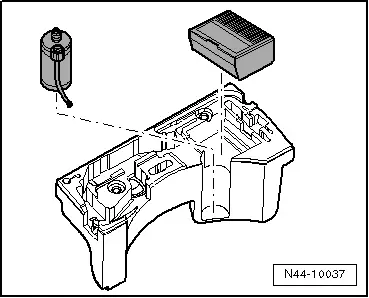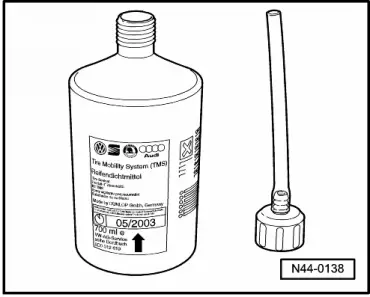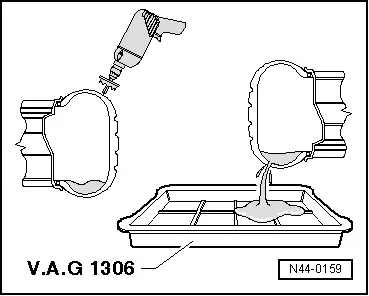Audi Q7: Vehicles with Break-Down Kit
Tire Sealant
 WARNING
WARNING
If tire sealant was used, then the wheel electronics on that particular wheel must be replaced.
Audi vehicles have either a spare wheel or a wheel repair kit, depending on equipment.
The wheel repair kit is located in the luggage compartment, where the spare tire would be stored if the vehicle was equipped with one. It contains a bottle of tire sealant next to the compressor.
Tire sealant in the bottle has a limited storage life.
Therefore, the expiration date is indicated on the bottle -arrow-.

In this example, the expiration date is 05/2003, it must be replaced.
If the bottle was opened, for example, for a punctured tire, it must also be replaced.

Tires, Removing
Tires which have been filled or sealed with tire sealant, must be drained before removing from wheel.
 WARNING
WARNING
- Prevent tire sealant from making contact with eyes and skin.
- It is harmful to health, can cause eye irritation and allergies.
- Wear protective gloves and glasses when removing tires.
- Set wheel on an even surface.
- Remove tire valve insert.
- Carefully drill hole in tire in area of shoulder using suitable drill or cutter.
- Hold wheel over drip tray and allow tire sealant to drain.
- Remove tire from rim.
- Clean wheel rim, for example using a damp cloth.

Tire Sealant, Disposing
Remainder of tire sealant or bottles still filled, date expired, must be disposed of.
Old tire sealant or remainder of tire sealant must not be mixed with other fluids or disposed of. To do so, follow disposal instructions in Handbook Service Organization; Environmental Protection and Disposal Practices.
Tires, Mounting
 WARNING
WARNING
If tire sealant was used, then the wheel electronics on that particular wheel must be replaced.
- Make sure wheel rim is clean.
- After using tire sealing liquid, wheel electronics must be replaced, since there is the possibility of incorrect measurements due to liquid deposits on pressure sensor.
- Insert a new tire valve.
- Remove the valve insert.
- Inflate tire to approximately 3 to 4 bar (43.5 to 58 psi), tire bead must audibly slide over rim hump.
- Install valve insert.
- Correct inflation pressure to the specified pressure.
- Balance wheel.

